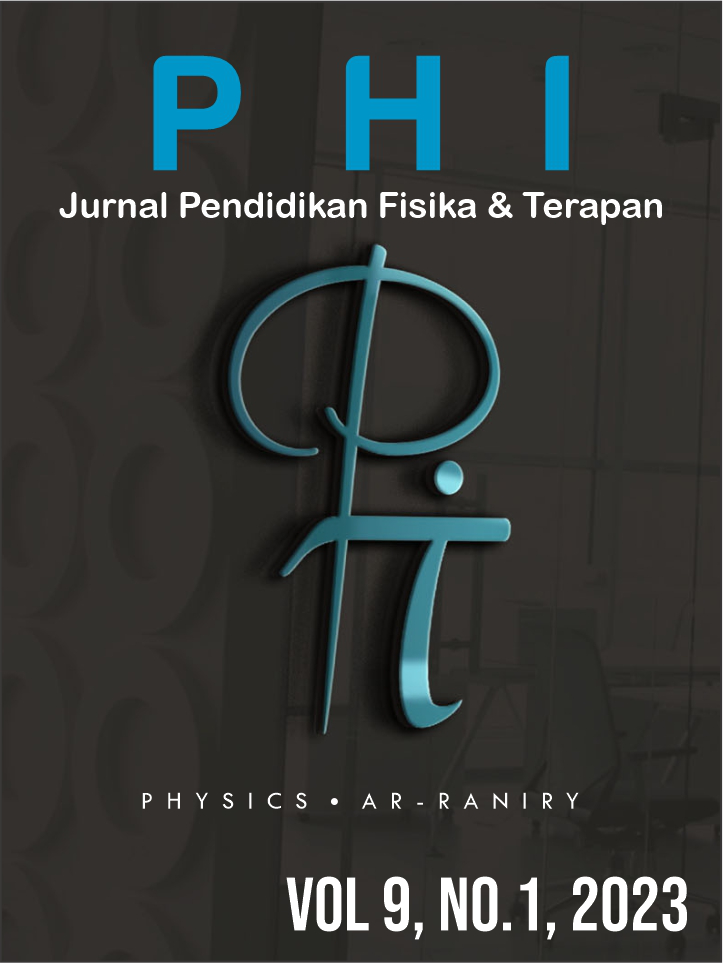Kinerja Fotokatalis Tunggal ZnO dan Komposit ZnO/Reduced Graphene Oxide (ZnO/rGO) di bawah Iradiasi Sinar Matahari
DOI:
https://doi.org/10.22373/p-jpft.v9i1.17228Abstract
Menurunnya kualitas air pada perairan merupakan salah satu dampak pencemaran limbah pewarna dari industri tekstil yang sulit untuk didegradasi secara biologi. Fotodegradasi menggunakan fotokatalis merupakan solusi yang efisien untuk polusi air akibat pewarna. Dalam penelitian ini, kinerja fotokatalis tunggal ZnO dan komposit ZnO/Reduced Graphene Oxide (ZnO/rGO) telah dikaji aktivitasnya dengan menggunakan iradiasi sinar matahari. Sampel fotokatalis diberi 2 perlakuan yaitu dengan pengadukan dan tanpa pengadukan pada larutan metilen biru. Hasil penelitian menunjukkan bahwa pada iradiasi selama 30 menit, penurunan kandungan metilen biru lebih tinggi ketika sampel ditambahkan komposit ZnO/rGO dibandingkan ZnO tunggal (dengan pengadukan), yaitu sebesar 30% (ZnO/rGO) dan 9% (ZnO). Sementara itu, lama waktu iradiasi juga mempengaruhi persentase penurunan kandungan metilen biru. Iradiasi selama 2 jam pada fotokatalis ZnO/rGO dan ZnO menunjukkan konsistensi dengan hasil iradiasi selama 30 menit. Perbedaan dari kedua proses ini adalah kecepatan penurunan warna metilen biru. Komposit ZnO/rGO yang diberlakukan pengadukan memiliki kecepatan paling tinggi dengan menyisakan 14% kandungan metilen biru. Dengan demikian, kinerja fotokatalis dipengaruhi oleh penambahan rGO pada ZnO, lama iradiasi, dan adanya proses pengadukan.References
Ajmal, A., Majeed, I., Malik, R.N., Idriss, H., Nadeem, M.A., 2014. Principles and mechanisms of photocatalytic dye degradation on TiO2 based photocatalysts: A comparative overview. RSC Adv. 4, 37003–37026. https://doi.org/10.1039/c4ra06658h
Ankamwar, B.G., Kamble, V.B., Annsi, J.I., Sarma, L.S., Mahajan, C.M., 2017. Solar photocatalytic degradation of methylene blue by ZnO nanoparticles. J. Nanosci. Nanotechnol. 17, 1185–1192. https://doi.org/10.1166/jnn.2017.12579
Bemis, R., Nelson, Ngatijo, Nurjanah, S., Maghviroh, N., 2019. Sintesis dan karakterisasi fotokatalis ZnO/karbon aktif dan aplikasinya pada degradasi rhodamin B. Chempublish J. 4, 101–113. https://doi.org/10.22437/chp.v4i2.7936
Houari, M., Saidi, M., Tabet, D., Pichat, P., Khalaf, H., 2005. The Removal of 4-chlorophenol and Dichloroacetic Acid in Water Using Ti-, Zr- and Ti/Zr-Pillared Bentonites as Photocatalyst. Am. J. Appl. Sci. 2, 1136–1140. https://doi.org/10.3844/ajassp.2005.1136.1140
Lellis, B., Fávaro-Polonio, C.Z., Pamphile, J.A., Polonio, J.C., 2019. Effects of textile dyes on health and the environment and bioremediation potential of living organisms. Biotechnol. Res. Innov. 3, 275–290. https://doi.org/10.1016/j.biori.2019.09.001
Liu, Q., 2020. Pollution and Treatment of Dye Waste-Water. IOP Conf. Ser. Earth Environ. Sci. 514. https://doi.org/10.1088/1755-1315/514/5/052001
Mirzaeifard, Z., Shariatinia, Z., Jourshabani, M., Rezaei Darvishi, S.M., 2020. ZnO Photocatalyst Revisited: Effective Photocatalytic Degradation of Emerging Contaminants Using S-Doped ZnO Nanoparticles under Visible Light Radiation. Ind. Eng. Chem. Res. 59, 15894–15911. https://doi.org/10.1021/acs.iecr.0c03192
Namratha, K., Kullaiah, B., Deepthi, B., 2018. Photo De-colorization of Cibacron Brilliant Yellow Dye Using ZnO Photo Catalyst under Sunlight. Prog. Petrochemical Sci. 1, 1–5. https://doi.org/10.31031/pps.2018.01.000505
Nisar, A., Saeed, M., Muneer, M., Usman, M., Khan, I., 2022. Synthesis and characterization of ZnO decorated reduced graphene oxide (ZnO-rGO) and evaluation of its photocatalytic activity toward photodegradation of methylene blue. Environ. Sci. Pollut. Res. 29, 418–430. https://doi.org/10.1007/s11356-021-13520-6
Pirgholi-Givi, G., Farjami-Shayesteh, S., Azizian-Kalandaragh, Y., 2020. The influence of irradiation intensity and stirring rate on the photocatalytic activity of titanium dioxide nanostructures prepared by the microwave-assisted method for photodegradation of MB from water. Phys. B Condens. Matter 578. https://doi.org/10.1016/j.physb.2019.411886
Qu, G., Fan, G., Zhou, M., Rong, X., Li, T., Zhang, R., Sun, J., Chen, D., 2019. Graphene-Modified ZnO Nanostructures for Low-Temperature NO 2 Sensing. ACS Omega 4, 4221–4232. https://doi.org/10.1021/acsomega.8b03624
Tanaka, K., Padermpole, K., Hisanaga, T., 2000. Photocatalytic degradation of commercial azo dyes. Water Res. 34, 327–333. https://doi.org/10.1016/S0043-1354(99)00093-7
Vasiljevic, Z.Z., Dojcinovic, M.P., Vujancevic, J.D., Jankovic-Castvan, I., Ognjanovic, M., Tadic, N.B., Stojadinovic, S., Brankovic, G.O., Nikolic, M. V., 2020. Photocatalytic degradation of methylene blue under natural sunlight using iron titanate nanoparticles prepared by a modified sol-gel method: Methylene blue degradation with Fe2TiO5. R. Soc. Open Sci. 7. https://doi.org/10.1098/rsos.200708
Vörösmarty, C.J., Green, P., Salisbury, J., Lammers, R.B., 2000. Global Water Resources : Vulnerability from Climate Change and Population Growth Contemporary Population RelaGlobal Water Resources : Vulnerability from Climate Change and Population Growth Contemporary Population Relative to Demand per Dischargetive to D. Science (80-. ). 289, 284–288.
Wismayanti, D., Diantariani, N., Santi, S., 2015. Pembuatan Komposit ZnO-Arang Aktif Sebagai Fotokatalis Untuk Mendegradasi Zat Warna Metilen Biru. J. Kim. 9, 109–116.
Zhao, J., Ren, W., Cheng, H.M., 2012. Graphene sponge for efficient and repeatable adsorption and desorption of water contaminations. J. Mater. Chem. 22, 20197–20202. https://doi.org/10.1039/c2jm34128j
Downloads
Published
Issue
Section
License
Authors who publish with Jurnal Phi agree to the following terms:
- Authors retain copyright and grant the journal right of first publication with the work simultaneously licensed under a Creative Commons Attribution License (CC BY 4.0) that allows others to share the work with an acknowledgment of the work's authorship and initial publication in this journal.
- Authors are able to enter into separate, additional contractual arrangements for the non-exclusive distribution of the journal's published version of the work (e.g., post it to an institutional repository or publish it in a book), with an acknowledgment of its initial publication in this journal.
- Authors are permitted and encouraged to post their work online (e.g., in institutional repositories or on their website) prior to and during the submission process, as it can lead to productive exchanges, as well as earlier and greater citation of published work (See The Effect of Open Access).

















